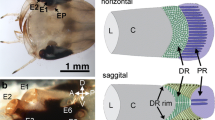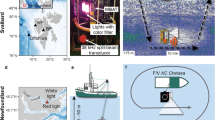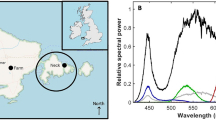Abstract
Hatchling marine turtles emerge at night from underground nests on oceanic beaches and then use visual cues to crawl from the nest site to the sea (“seafinding”). However, the light wavelengths (λ’s) used to accomplish this orientation have not been thoroughly documented, nor do we understand why some λ’s are favored over others. We measured nocturnal radiance on the horizon at 20 nm intervals between 340 and 600 nm at two nesting beach sites and then, under laboratory conditions, determined the lowest intensities of those λ’s that induced green turtle and loggerhead hatchlings to crawl toward each light source (a low positive “phototaxis threshold”). Both species were similarly sensitive and were attracted to all λ’s. Radiance measures at all λ’s were greater toward the seaward horizon than toward the landward horizon, providing an important orientation cue regardless of variation in lunar illumination. Previous studies document that both species detect λ’s longer than those that are most attractive. We hypothesize that seafinding is a specialized response mediated by cones that are sensitive to the shorter λ’s (to minimize the effects of dark noise) but such as rods, are especially sensitive to low levels of nocturnal illumination.


Similar content being viewed by others
References
Aho AC, Donner K, Hydén C, Larsen LO, Reuter T (1988) Low retinal noise in animals with low body temperatures allows high visual sensitivity. Nat Lond 334:348–350
Barlow HB (1956) Retinal noise and absolute threshold. J Opt Soc Am 46:634–639
Baylor DA, Mathews G, Yaw KW (1980) Two components of electrical dark noise in toad retinal rod outer segments. J Physiol 309:591–621
Bustard HR (1967) Mechanisms of nocturnal emergence from the nest in green turtle hatchlings. Nat Lond 214:317
Carr A, Ogren LH (1960) The ecology and migrations of sea turtles. IV. The green turtle in the Caribbean Sea. Bull Amer Mus Nat Hist 121:6–45
Cornsweet TN (1962) The staircase-method in psychophysics. Am J Psychol 75:485–491
Cronin TW, Johnsen S, Marshal NJ, Warrant EJ (2014) Visual Ecology. Princeton University Press, Princeton
Dixon WJ, Mood AM (1948) A method for obtaining and analyzing sensitivity data. J Am Stat Assoc 43:109–126
Drake DL, Spotila JR (2002) Thermal tolerances and the timing of sea turtle hatchling emergence. J Therm Biol 27:71–81
Ehrenfeld DW (1968) The role of vision in the sea-finding orientation of the green turtle (Chelonia mydas). Anim Behav 16:281–287
Fasick JI, Robinson PR (2000) Spectral tuning mechanisms of marine mammal rhodopsins and correlations with foraging depth. Vis Neurosci 17:781–788
Fritsches KA, Warrant EJ (2013) Vision. In: Wyneken J, Lohmann KJ, Musick JA (eds) The biology of sea turtles, vol III. CRC Press, Boca Raton, pp 32–53
Glen F, Broderick AC, Godley BJ, Hays GC (2005) Patterns in the emergence of green (Chelonia mydas) and loggerhead (Caretta caretta) turtle hatchlings from their nests. Mar Biol 146:1039–1049
Granda AM, O’Shea PJ (1972) Spectral sensitivity of the green turtle (Chelonia mydas mydas) determined by electrical responses to heterochromatic light. Brain Behav Evol 5:143–154
Hauser FE, Chang BSW (2017) Insights into visual pigment adaptation and diversity from model ecological and evolutionary systems. Curr Opin Genet Dev 47:110–120
Horch KW, Gocke JP, Salmon M, Forward RB (2008) Visual spectral sensitivity of hatchling loggerhead (Caretta caretta L.) and leatherback (Dermochelys coriacea L.) sea turtles, as determined by single-flash electroretinography. Mar Freshw Behav Physiol 41:79–91
Kawamura G, Naohara T, Tanaka Y, Nishi T, Anraku K (2009) Near-ultraviolet radiation guides the emerged hatchlings of loggerhead turtles Caretta caretta (Linnaeus) from a nesting beach to the sea at night. Mar Freshw Behav Physiol 42:19–30
Levitt HC (1971) Transformed up-down methods in psychoacoustics. J Acoust Soc Am 49:467–477
Liebman PA, Granda AM (1971) Microspectrophotometric measurements of visual pigments in two species of turtle, Pseudemys scripta and Chelonia mydas. Vision Res 11:105–114
Limpus C (1971) Sea turtle ocean finding behaviour. Search 2:385–387
Loew ER, Govardovskii VI (2001) Photoreceptors and visual pigments in the red-eared turtle, Trachemys scripta elegans. Vis Neurosci 18:753–757
Lohmann KJ, Witherington BE, Lohmann CM, Salmon M (1997) Orientation, navigation, and natal beach homing in sea turtles. In: Lutz PL, Musick PA (eds) The biology of sea turtles. CRC Press, Boca Raton, pp 107–136
Mäthger LM, Litherland L, Fritsches KA (2007) An anatomical study of the visual capabilities of the green turtle, Chelonia mydas. Copeia 2007:169–179
Mrosovsky N (1967) How turtles find the sea. Sci J 3:52–57
Mrosovsky N (1968) Nocturnal emergence of hatchling sea turtles: control by thermal inhibition of activity. Nature 220:1338–1339
Mrosovsky N, Carr A (1967) Preference for light of short wavelengths in hatchling green sea turtles, Chelonia mydas, tested on their natural nesting beaches. Behaviour 28:217–231
Mrosovsky N, Shettleworth SJ (1968) Wavelength preferences and brightness cues in the water finding behaviour of sea turtles. Behaviour 32:211–257
Salmon M, Wyneken J, Fritz E, Lucas M (1992) Seafinding by hatchlings sea turtles: role of brightness, silhouette and beach slope as orientation cues. Behaviour 122:56–73
Schott RK, Müller J, Yang CG, Bhattacharyya N, Chan N et al (2016) Evolutionary transformation of rod photoreceptors in the all-cone retina of a diurnal garter snake. Proc Nat Acad Sci 113:356–361
Schuyler QA, Wilcox C, Townsend K, Hardesty BD, Marshall NJ (2014) Mistaken identity? Visual similarities of marine turtle debris to natural prey items of sea turtles. BMC Ecol 14:14
Simöes BF, Gower DJ (2017) Visual pigment evolution in reptiles. Wiley, Chichester. https://doi.org/10.1002/9780470015902.a0025419
Verheijen FJ (1985) Photopollution: artificial light optic spatial control systems fail to cope with. Incidents, causation, remedies. Exp Biol 44:1–18
Warrant EJ (1999) Seeing better at night: life style, eye design, and the optimum strategy of spatial and temporal summation. Vision Res 39:1611–1630
Witherington BE (1997) The problem of photopollution for sea turtles and other nocturnal animals. In: Clemmons JR, Buchholz R (eds) Behavioral approaches to conservation in the wild. Cambridge University Press, Cambridge, pp 303–328
Witherington BE, Bjorndal KA (1991a) Influences of wavelength and intensity on hatchling sea turtle phototaxis: implications for sea-finding behavior. Copeia 1991:1060–1069
Witherington BE, Bjorndal KA (1991b) Influences of artificial lighting on the seaward orientation of hatchling loggerhead turtles Caretta caretta. Biol Cons 55:139–149
Witherington BE, Bjorndal KA, McCabe CM (1990) Temporal pattern of nocturnal emergence of loggerhead turtle hatchlings from natural nests. Copeia 1990:1165–1168
Young M, Salmon M, Forward R (2012) Visual wavelength discrimination by the loggerhead turtle, Caretta caretta. Biol Bull (Woods Hole) 222:46–55
Zar JH (1999) Biostatistical analysis, 4th edn. Prentice-Hall, New Jersey
Acknowledgements
We thank K. Rusenko and D. Anderson of the Gumbo Limbo Environmental Complex for providing access to the sea turtle nests and hatchlings on the beach at Boca Raton, Florida. We thank T. Cronin and S. Johnsen for their responses to our frequent requests for advice and guidance. R. Forward loaned us many interference filters. His comments, and those of two anonymous referees, improved manuscript clarity and organization. LC completed this study as part of the requirements for a Master of Science degree in the Department of Biological Sciences at Florida Atlantic University. She thanks S. Kajiura and J. Wyneken, members of the thesis committee, for their advice and encouragement.
Funding
Financial support was provided by the Department of Biological Sciences, Florida Atlantic University, and by the National Save-the-Sea-Turtle Foundation of Fort Lauderdale, Florida, USA.
Author information
Authors and Affiliations
Contributions
LC collected the hatchlings and did the experiments with the assistance of two undergraduate students, CS and AF. MS recommend the project and served as an academic advisor. LC and MS wrote the paper.
Corresponding author
Ethics declarations
Conflict of interest
The authors declare that they have no conflict of interest. This study was permitted by the Florida Fish and Wildlife Conservation Commission (TP 173) and approved by the Florida Atlantic University IACUC Committee (Protocol A16-22).
Rights and permissions
About this article
Cite this article
Celano, L., Sullivan, C., Field, A. et al. Seafinding revisited: how hatchling marine turtles respond to natural lighting at a nesting beach. J Comp Physiol A 204, 1007–1015 (2018). https://doi.org/10.1007/s00359-018-1299-4
Received:
Revised:
Accepted:
Published:
Issue Date:
DOI: https://doi.org/10.1007/s00359-018-1299-4




